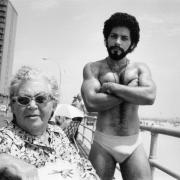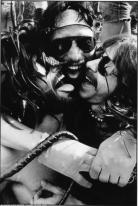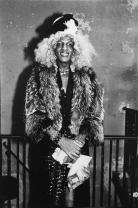Of Women and Angels
Created by Anna O'Brien on Sat, 03/30/2024 - 12:09
This timeline provides a sociohistorical context for Arlene Gottfried's 1976 Angel and Woman on Boardwalk, Brighton Beach.

Gottfried, Arlene. Angel and Woman on Boardwalk, Brighton Beach. 1976. https://slate.com/culture/2014/11/arlene-gottfried-sometimes-outrageous-looks-at-the-vibrancy-of-new-york-city-in-the-1980s-photos.html. Accessed 30 March 2024.
Timeline
Chronological table
| Date | Event | Created by | Associated Places | |
|---|---|---|---|---|
| 15 Aug 1969 to 18 Aug 1969 |
WoodstockAccording to Figes, Arlene Gottfried took some of her “first photographs at Woodstock in 1969.” Woodstock was a music festival on a dairy farm that lasted for three days from August 15 to August 18. The audience was about 500,000 strong and mostly consisted of young hippies who protested the Vietnam War and wanted to “spread a message of unity and peace” (History.com Editors, “Woodstock”). Initially, the event was supposed to make money, however, the staff weren’t entirely ready for that amount of people, so the festival goers snuck in through gaps in the fences. Ticket collection was swiftly abandoned due to the large number of people who showed up early. There was bad weather which contributed to muddy conditions, and there was also a lack of food and water so there had to be some flown in (Troutman). Despite the conditions, the general atmosphere was harmonious and community-driven, though different people have different reasons as to why that is. The musical acts consisted of artists like Jimi Hendrix and Richie Havens (History.com Editors, “Woodstock”).
Figes, Lydia. “Arlene Gottfried, the Street Photographer Who Captured the Soul of 1980s New York.” ELEPHANT, 16 Feb. 2022, elephant.art/arlene-gottfried-the-street-photographer-who-captured-the-soul-of-1980s-new-york/. Accessed 17 Mar. 2024. Gottfried, Arlene. “Men Mouth Open, Central Park, NY.” Galerie Bene Taschen, 1970, www.benetaschen.com/artists/artists/gottfried.php#. Accessed 30 Mar. 2024. History.com Editors. “Woodstock.” History.com, A&E Television Network, 21 Aug. 2018, www.history.com/topics/1960s/woodstock. Accessed 17 Mar. 2024. Troutman, John. “Remembering Woodstock.” Americanhistory.si.edu, 16 Aug. 2019, americanhistory.si.edu/explore/stories/remembering-woodstock. Accessed 1 Apr. 2024. |
Anna O'Brien | ||
| 1970 |
Brighton BeachIn the 1970s, Brighton Beach, the place in which the photo was taken, was a place in which immigrants from the Soviet Union and Ukraine were arriving. At first, there was a decline in the living standards of the area with people moving out of the area and into the suburbs on top of budget cuts that the area was already facing. Landlords left their properties without repair making it so that the houses were deteriorating, crime also increased at the time. Since young people were moving to the suburbs, that left older people left; this led to homes being “converted into single-room occupancy housing for welfare families, the elderly, and mental hospital patients.” Then, Jewish immigrants facing religious discrimination in their respective home countries came to America following the change in Soviet Union immigration policy, halting the decline of Brighton Beach. An estimated forty thousand Jewish immigrants found a haven in Brighton Beach which became known as “Little Odessa”. Young people and families started to be seen in the area again with the influx of young immigrants, thus people put more money back into the area once more. Although it wasn’t all great all the time, they still faced opposition from American Jews who didn’t like that they weren’t practicing religion like they did and instead were more city-minded (Brooklyn Jewish Historical Initiative).
“Brighton Beach.” Flashbak, 1972, flashbak.com/snapshots-of-brighton-in-the-1970s-397886/. Accessed 31 Mar. 2024. Brooklyn Jewish Historical Initiative. “Brighton Beach | the Brooklyn Jewish Historical Initiative (BJHI).” BJHI, 2024, brooklynjewish.org/neighborhoods/brighton-beach/. Accessed 17 Mar. 2024. |
Anna O'Brien | ||
| 1972 |
Greenwich VillageIn 1972, Arlene Gottfried moved to Greenwich Village during a time that was known to some to be “New York’s seismic identity shift” (Figes). Three years before she moved to Greenwich, the Stonewall riots broke out on June 28, 1969. The bar was owned by the mafia, so they paid off members of the police to look the other way at their activities—which included illegally selling alcohol and letting their patrons partake in homosexual activities which were illegal at the time—or at least tip them off before a raid. During a raid that the police did not tip them off to, patrons and neighbors became agitated at the treatment of their peers and began to riot, which lasted for five days (History.com Editors, “Stonewall Riots”). A year later, the first gay pride parade in the history of the U.S. occurred on the anniversary of the raid of the Stonewall Inn and the riots that occurred afterward (CBS New York). In her time living in Greenwich, Gottfried took many photos of the “pre-gentrified and pre-financialised New York”. She socialized with theater people, addicts, rebels, and “Stonewall activists like Marsha P Johnson.” In order to make a living she worked for an advertising agency, which found a way to provide works for The New York Times Magazine, LIFE, and Newsweek (Figes).
CBS New York. “Biggest New York Events of the 1970s.” Www.cbsnews.com, 15 Jan. 2015, www.cbsnews.com/newyork/news/biggest-new-york-events-of-the-1970s/. Accessed 1 Apr. 2024. Figes, Lydia. “Arlene Gottfried, the Street Photographer Who Captured the Soul of 1980s New York.” ELEPHANT, 16 Feb. 2022, elephant.art/arlene-gottfried-the-street-photographer-who-captured-the-soul-of-1980s-new-york/. Accessed 17 Mar. 2024. Gottfried, Arlene. “Marsha P. Johnson in Blonde Wig.” Daniel Cooney Fine Art, 1983, www.danielcooneyfineart.com/artists/arlene-gottfried/series/sometimes-overwhelming?view=slider. Accessed 31 Mar. 2024. History.com Editors. “Stonewall Riots.” History.com, A&E Television Networks, 31 May 2017, www.history.com/topics/gay-rights/the-stonewall-riots. Accessed 17 Mar. 2024. |
Anna O'Brien | ||
| 1 Spring 2024 |
My Docent StoryThe reason that I offered that background concerning those three events is because it helps me to explain what Angel and Woman on Boardwalk, Brighton Beach was doing socially/culturally and/or politically when Arlene Gottfried created it. These events help me provide context for what types of people Gottfried photographed. She photographed primarily people who were disenfranchised in some way, shape, or form like LGBTQ+ people or immigrants escaping religious persecution. Her art reflects the people who she was around the most, providing snapshots of their everyday lives. These two people aren’t doing anything particularly noteworthy; one is just sitting on the bench while the other has their arms crossed across their chest. One could surmise that these two are disenfranchised in some form, perhaps they are immigrants from the Soviet Union who are finally able to freely express themselves or a pair of friends that are queer. There is also the fact that this photo was taken in an era when a lot of change was occurring. The photograph might be one of the last ones taken in that area with those surroundings. These people might just be passing through, or they might be going through an individual change. This helps us understand that part of Gottfried’s work helps document the people and landscape as they were rather than what they became. In my choosing of this specific background information, I wanted to demonstrate how this was just Gottfried’s life and she photographed what she knew. She knew people and their complexities and took a snapshot of that. She didn’t exaggerate anything in her work, just showed it how it was. |
Anna O'Brien |



